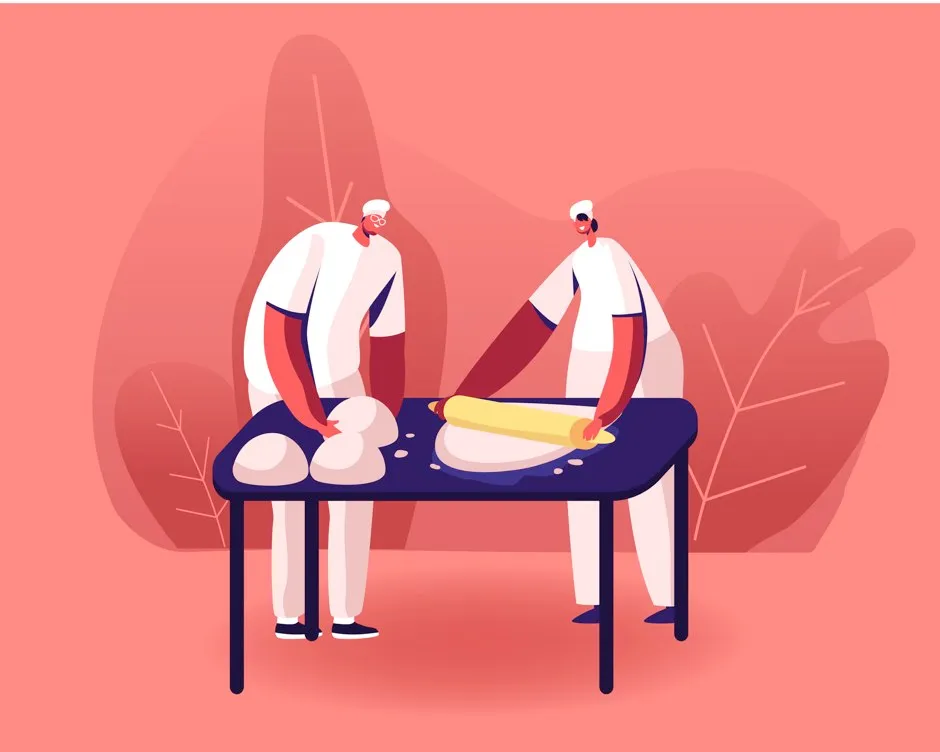Bread is the ultimate comfort food
I think bread is part of our DNA. If you go back in time, there are references to breaking, sharing and eating bread. There’s a certain satisfaction that comes from baking bread and then sharing it with the people you love.
Our love affair with bread goes back a long way
Archaeological evidence suggests that Natufian hunter-gatherers were making flatbreads from wild cereals over 12,000 years ago, but baking could have started even earlier. 30,000-year-old grinding stones have been found but no one is sure if they were used for making flour.
Treat it like a science experiment
Follow the instructions. Baking is a science, so don’t guesstimate things. Make sure, for example, that the water you add is at the right temperature. Too hot or too cold and the yeast won’t work. If it says to add a certain amount of yeast or salt, make sure you do it.
Strong flour is best
Strong flour has the highest amount of protein in it. It contains glutenin and gliadin which combine to make gluten when water is added. If you use flour with a low protein content, the bread is likely to be heavy and dense.
Kneading is important
As the dough is stretched, it helps to line up the otherwise messy strands of gluten. It’s a bit like combing the tangles from your hair! This makes the bread stronger.
Know your yeast
Yeast is a single-celled organism. Bakers use one species; Saccharomyces cerevisiae, which means “sugar-eating fungi.” As it eats sugar, it produces carbon dioxide, which helps make the bread light and bubbly. This is fermentation.
Connoisseurs of bread may prefer live yeast, but it only survives for a few weeks. Dry yeast has a longer shelf life because it’s dehydrated.
I recommend another type of yeast, called instant yeast, which is even more dehydrated. It rehydrates and gets to work on the bread very quickly. It lasts longer too.
Don’t forget the salt
Salt is hygroscopic, so it attracts water. When it’s mixed into a dough that contains yeast, it absorbs moisture and helps to control the fermentation.

Proving cupboards are over-rated
They work, but there are many other ways to prove bread. Proving is when you leave the yeast to work its magic. Cupboards provide a constant temperature and humidity which is good, but you can also cover your dough with a tea towel and ‘cold prove’ it at room temperature, or leave it in a warm oven that has been switched off.
Try the finger test!
Knowing when the dough has proved is a bit of an art. When it has doubled in size, press the dough with your finger. If it bounces back, it’s ready. If it doesn’t, then it needs a little longer.
There is chemistry behind a crusty top
The much sought after ‘brown crusty top’ is caused by the Maillard reaction; a chemical reaction between amino acids and sugars, that requires moisture and heat.
One option is to spray the dough with water a few times whilst it is cooking. Another is to fill a baking tray with ice cubes and place it in the bottom of your preheated oven.
Keeping it fresh
Bread starts to go off the minute you take it out of the oven because it starts losing moisture. A chemical reaction called starch retrogradation changes the structure of starch molecules and forces water out of the bread.
The best way to keep homemade bread fresh is to bake it, let it cool, then quickly slice it and put it in the freezer.
Yeast-free alternatives
If you can’t get any yeast, there are lots of alternatives to try. Chapatis are easy to make, but you could also try rye bread from sprouted wheat or tortilla bread from corn.
Go gluten-free
Gluten strands bind things together. Xanthan gum is a gluten-free binding alternative that can be added to many gluten-free flours, but I often find that the bread it produces is too dense.
My advice is not to bother with special gluten-free flours. Go for naturally gluten-free grains like rice, chickpea, soy, bean and corn flour. They’re really straightforward to bake with.
Read more fromA scientist’s guide to life:
- How not to date a psychopath
- How to beat a cold
- How to survive a hangover
- How to master spring cleaning
- How to be a better conversationalist
- How to navigate digital living
Next-level bread making
If you’re ready for something a little trickier, you could always try sourdough. Sourdough bread contains the same four basic ingredients as normal bread – flour, yeast, salt and water – with added bacteria.
Sourdough bakers keep starter cultures of bacteria and yeast which they have to feed and manage. It’s a bit like keeping a pet!
Don’t be afraid to fail
You might not get it right first time, but if you haven’t had a loaf go wrong, then you haven’t learned. The more you experiment with bread, the better you get at it. Don’t give up!
